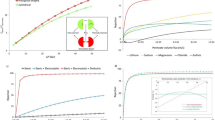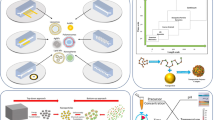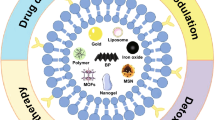Abstract
Nanoparticle transport to the opening of the single nanopore created on the cell membrane during the electroporation is studied. First, the permeabilization of a single cell located in a microchannel is investigated. When the nanopores are created, the transport of the nanoparticles from the surrounding liquid to the opening of one of the created nanopores is examined. It was found that the negatively charged nanoparticles preferably move into the nanopores from the side of the cell membrane that faces the negative electrode. Opposite to the electro-osmotic flow effect, the electrophoretic force tends to draw the negatively charged nanoparticles into the opening of the nanopores. The effect of the Brownian force is negligible in comparison with the electro-osmosis and the electrophoresis. Smaller nanoparticles with stronger surface charge transport more easily to the opening of the nanopores. Positively charged nanoparticles preferably enter the nanopores from the side of the cell membrane that faces the positive electrode. On this side, both the electrophoretic and the electro-osmotic forces are in the same directions and contribute to bring the positively charged particles into the nanopores.








Similar content being viewed by others
References
Algar WR, Krull UJ (2009a) Multiplexed interfacial transduction of nucleic acid hybridization using a single color of immobilized quantum dot donor and two acceptors in fluorescence resonance energy transfer. Anal Chem 82(1):400–405
Algar WR, Krull UJ (2009b) Toward a multiplexed solid-phase nucleic acid hybridization assay using quantum dots as donors in fluorescence resonance energy transfer. Anal Chem 81(10):4113–4120
Bilska AO, DeBruin KA, Krassowska W (2000) Theoretical modeling of the effects of shock duration, frequency, and strength on the degree of electroporation. Bioelectrochemistry 51(2):133–143
Cao Y, Yang J, Yin ZQ, Luo HY, Yang M, Hu N, Zheng XL (2008) Study of high-throughput cell electrofusion in a microelectrode-array chip. Microfluid Nanofluid 5(5):669–675
Chambers EL, De Armendi J (1979) Membrane potential, action potential and activation potential of eggs of the sea urchin Lytechinus variegates. Exp Cell Res 122(1):203–218
DeBruin KA, Krassowska W (1999a) Modeling electroporation in a single cell. I. Effects of field strength and rest potential. Biophys J 77(3):1213–1224
DeBruin KA, Krassowska W (1999b) Modeling electroporation in a single cell. II. Effects of ionic concentrations. Biophys J 77(3):1225–1233
Fei Z, Wang S, Xie Y, Henslee BE, Koh CG, Lee LJ (2007) Gene transfection of mammalian cells using membrane sandwich electroporation. Anal Chem 79(15):5719–5722
Fox MB, Esveld DC, Valero A, Luttge R, Mastwijk HC, Bartels PV, Van den Berg A, Boom RM (2006) Electroporation of cells in microfluidic devices: a review. Anal Bioanal Chem 385(3):474–485
Freeman SA, Wang MA, Weaver JC (1994) Theory of electroporation of planar bilayer membranes: predictions of the aqueous area, change in capacitance, and pore–pore separation. Biophys J 67(1):42
Glaser RW, Leikin SL, Chernomordik LV, Pastushenko VF, Sokirko AI (1988) Reversible electrical breakdown of lipid bilayers: formation and evolution of pores. Biochimica et Biophysica Acta (BBA)-Biomembranes 940(2):275–287
Gothelf A, Mir LM, Gehl J (2003) Electrochemotherapy: results of cancer treatment using enhanced delivery of bleomycin by electroporation. Cancer Treat Rev 29(5):371
Granot Y, Rubinsky B (2008) Mass transfer model for drug delivery in tissue cells with reversible electroporation. Int J Heat Mass Transf 51(23):5610–5616
Henon S, Lenormand G, Richert A, Gallet F (1999) A new determination of the shear modulus of the human erythrocyte membrane using optical tweezers. Biophys J 76(2):1145–1151
Herwadkar A, Banga AK (2012) Peptide and protein transdermal drug delivery. Drug Discov Today: Technol 9(2):e147–e154
Hibino M, Itoh H, Kinosita JK (1993) Time courses of cell electroporation as revealed by submicrosecond imaging of transmembrane potential. Biophys J 64(6):1789–1800
Hsu JP, Yeh LH, Ku MH (2007) Evaluation of the electric force in electrophoresis. J Colloid Interface Sci 305(2):324–329
Huang Y, Rubinsky B (2003) Flow-through micro-electroporation chip for high efficiency single-cell genetic manipulation. Sens Actuat A 104(3):205–212
Israelachvili JN (2011) Intermolecular and surface forces. Rev. 3 edn. Academic press, San Diego
Kadaksham AT, Singh P, Aubry N (2004) Dielectrophoresis of nanoparticles. Electrophoresis 25(21–22):3625–3632
Kim SK (2007) Continuous low-voltage dc electroporation on a microfluidic chip with polyelectrolytic salt bridges. Anal Chem 79(20):7761–7766
Koneshan S, Rasaiah JC, Lynden-Bell RM, Lee SH (1998) Solvent structure, dynamics, and ion mobility in aqueous solutions at 25 C. J Phys Chem B 102(21):4193–4204
Krassowska W, Filev PD (2007) Modeling electroporation in a single cell. Biophys J 92(2):404–417
Lee ES, Robinson D, Rognlien JL, Harnett CK, Simmons BA, Ellis CRB, Rafael V, Davalos RV (2006) Microfluidic electroporation of robust 10-μm vesicles for manipulation of picoliter volumes. Bioelectrochemistry 69(1):117–125
Lee WG, Demirci U, Khademhosseini A (2009) Microscale electroporation: challenges and perspectives for clinical applications. Integr Biol 1(3):242–251
Li D (2004) Electrokinetics in microfluidics (Vol. 2). Academic Press, Toronto
Li S (2008) Electroporation protocols: preclinical and clinical gene medicine. Humana Press, Totowa
Li J, Lin H (2011) Numerical simulation of molecular uptake via electroporation. Bioelectrochemistry 82(1):10–21
Lin YH, Lee GB (2009) An optically induced cell lysis device using dielectrophoresis. Appl Phys Lett 94(3):033901–033901
Liu D, Maxey MR, Karniadakis GE (2005) Simulations of dynamic self-assembly of paramagnetic microspheres in confined microgeometries. J Micromech Microeng 15(12):2298
Lodish HF, Baltimore D, Berk A, Darnell JE (1995) Molecular cell biology. WH Freeman, New York, pp 453–456
Miklavcic D, Towhidi L (2010) Numerical study of the electroporation pulse shape effect on molecular uptake of biological cells. Radiol Oncol 44(1):34–41
Movahed S, Li D (2011a) Electrokinetic transports through nanochannels. Electrophoresis J 32:1259–1267
Movahed S, Li D (2011b) Microfluidics cell electroporation. Microfluid Nanofluid 10(4):703–734
Movahed S, Li D (2012a) Electrokinetic motion of a rectangular nanoparticle in a nanochannel. J Nanopart Res 14(8):1–15
Movahed S, Li D (2012b) Electrokinetic transport through the nanopores in cell membrane during electroporation. J Colloid Interface Sci 369(1):442–452
Movahed S, Li D (2013) A theoretical study of single-cell electroporation in a microchannel. J Membr Biol 246(2):151–160
Neu JC, Krassowska W (1999) Asymptotic model of electroporation. Phys Rev E 59(3):3471
Neu JC, Smith KC, Krassowska W (2003) Electrical energy required to form large conducting pores. Bioelectrochemistry 60(1):107–114
Schaper J, Bohnenkamp H, Noll T (2007) New electrofusion devices for the improved generation of dendritic cell-tumour cell hybrids. In: Cell technology for cell products, Springer, Dordrecht, pp 207–216
Smith KC, Neu JC, Krassowska W (2004) Model of creation and evolution of stable electropores for DNA delivery. Biophys J 86(5):2813–2826
Talele S, Gaynor P, Cree MJ, Van Ekeran J (2010) Modelling single cell electroporation with bipolar pulse parameters and dynamic pore radii. J Electrostat 68(3):261–274
Valero A, Post JN, Van Nieuwkasteele JW, Ter Braak PM, Kruijer W, Van den Berg A (2007) Gene transfer and protein dynamics in stem cells using single cell electroporation in a microfluidic device. Lab Chip 8(1):62–67
Vassanelli S, Bandiera L, Borgo K, Cellere G, Santoni L, Bersani C, Salamon M, Zaccolo M, Lorenzelli L, Girardi S, Maschietto M, Maschio MD, Paccagnella A (2008) Space and time-resolved gene expression experiments on cultured mammalian cells by a single-cell electroporation microarray. New Biotechnol 25(1):55–67
Wang S, Zhang X, Wang W, Lee LJ (2009) Semicontinuous flow electroporation chip for high-throughput transfection on mammalian cells. Anal Chem 81(11):4414–4421
Wang M, Orwar O, Olofsson J, Weber SG (2010) Single-cell electroporation. Anal Bioanal Chem 397(8):3235–3248
Zaharoff DA, Henshaw JW, Mossop B, Yuan F (2008) Mechanistic analysis of electroporation-induced cellular uptake of macromolecules. Exp Biol Med 233(1):94–105
Zangle TA, Mani A, Santiago JG (2010) Theory and experiments of concentration polarization and ion focusing at microchannel and nanochannel interfaces. Chem Soc Rev 39(3):1014–1035
Zhao X, Zhang M, Yang R (2010) Control of pore radius regulation for electroporation-based drug delivery. Commun Nonlinear Sci Numer Simul 15(5):1400–1407
Zheng Z, Hansford DJ, Conlisk AT (2003) Effect of multivalent ions on electroosmotic flow in micro-and nanochannels. Electrophoresis 24(17):3006–3017
Zhu T, Luo C, Huang J, Xiong C, Ouyang Q, Fang J (2010) Electroporation based on hydrodynamic focusing of microfluidics with low dc voltage. Biomed Microdevices 12(1):35–40
Acknowledgments
The authors wish to thank the financial support of the Canada Research Chair program and the Natural Sciences and Engineering Research Council (NSERC) of Canada through a research grant to D. Li.
Author information
Authors and Affiliations
Corresponding author
Rights and permissions
About this article
Cite this article
Movahed, S., Li, D. Electrokinetic transport of nanoparticles to opening of nanopores on cell membrane during electroporation. J Nanopart Res 15, 1511 (2013). https://doi.org/10.1007/s11051-013-1511-y
Received:
Accepted:
Published:
DOI: https://doi.org/10.1007/s11051-013-1511-y




